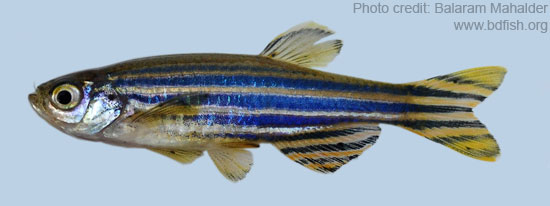
Systematic position
Phylum: Chordata
Class: Actinopterygii (Ray-finned fishes)
Order: Cypriniformes (Carps)
Family: Cyprinidae (Minnows and carps)
Genus: Danio
Species: D. rerio
Synonyms
Barilius rerio (Hamilton, 1822)
Brachydanio frankei Meinken, 1963
Brachydanio rerio (Hamilton, 1822)
Cyprinus chapalio Hamilton, 1822
Cyprinus rerio Hamilton, 1822
Danio frankei (Meinken, 1963)
Danio lineatus Day, 1868
Nuria rerio (Hamilton, 1822)
Perilampus striatusMcClelland, 1839
Common/local names
English: Zebra danio and Zebrafish
Bangladesh: Anju (আঞ্জু)
India: Anju (West Bengal); Poncha-geraldi (Orissa); Chintaku-parega (Andhra Pradesh) and Aratti and Sellai-palava (Tamil Nadu) (Talwar and Jhingran, 1991).
Distributions: Bangladesh, India (West Bengal to Krishna river system), Nepal and Pakistan (Talwar and Jhingran, 1991).
Conservation status: Not threatened in Bangladesh (IUCN Bangladesh, 2000).
Morphology: Ventral profile more arched than that of dorsal. Mouth oblique and cleft of mouth extends to below anterior end of orbit. Barbels two pairs (rostral and maxillary). Dorsal starts opposite anal and caudal forked equal lobe. 26-28 scales present on along side of the body and no lateral line (Rahman, 1989 and 2005).
Four metallic blue longitudinal bands, separated by three narrow silver ones. Three lower blue bands produced along caudal fin. Anal with three transverse blue bands. Paired fins colorless. Head 4.0-4.2 in standard, 5.0-5.2 in total length. Height 3.6-4.1 in standard, 4.5-5.2 in total length. Eye 2.7 in head; snout 0.5, interorbital 1.0 (Rahman, 1989 and 2005).
Fin formula:
D. 2/7; P1. 13; P2. 1/6; A. 2-3/11-13 (Rahman, 1989 and 2005)
D ii 6-7; A ii-iii 12-13; P i 11-12; V i 6 (Talwar and Jhingran, 1991)
D. 9(2/7); A. 15-16(2-3/12-13); C. 19 (Shafi and Quddus, 2001)
Maximum lengths: 2.9 cm (Rahman, 1989 and 2005) and 4.5 cm (Talwar and Jhingran, 1991).
Habitats: Found in rivers, canals, beels, haors and baors (Shafi and Quddus, 2001). Inhibits streams, ditches, ponds and beels throughout Bangladesh (Rahman, 1989 and 2005). Inhibits slow moving to stagnant standing water bodies, especially rice fields (Talwar and Jhingran, 1991).
Economic importance: As aquarium or ornamental fish. Probably the finest small tropical aquarium fish (Talwar and Jhingran, 1991).
____________________________________________________
REFERENCES
Day F. 1868. On some new fishes from Madras. Proceedings of the General Meetings for Scientific Business of the Zoological Society of London 1868 (pt 1): 192-199.
Hamilton F. 1822. An account of the fishes found in the river Ganges and its branches. Edinburgh & London. An account of the fishes found in the river Ganges and its branches.: i-vii + 1-405, Pls. 1-39.
IUCN Bangladesh. 2000. Red book of threatened fishes of Bangladesh, IUCN- The world conservation union. xii+116 pp.
McClelland J. 1839. Indian Cyprinidae. Asiatic Researches v. 19 (pt 2): 217-471, Pls. 37-61.
Meinken H. 1963. Mitteilungen der Fischbestimmungsstelle des VDA XLII: Brachydanio frankei spec. nov., der Leopard-Danio. v. 42: 39-43.
Rahman AKA. 1989. Freshwater Fishes of Bangladesh, 1st edition, Zoological Society of Bangladesh, Department of Zoology, University of Dhaka, Dhaka-1000, pp. 101-102.
Rahman AKA. 2005. Freshwater Fishes of Bangladesh, 2nd edition, Zoological Society of Bangladesh, Department of Zoology, University of Dhaka, Dhaka-1000, pp. 118-119.
Shafi M and Quddus MMA. 2001. Bangladesher Matsho Shampad (Fisheries of Bangladesh) (in Bengali), Kabir publication. Dhaka, Bangladesh. pp. 162-163.
Talwar PK and Jhingran AG. 1991. Inland Fishes of India and Adjacent Countries, Vol. 1, Oxford & IBH Publishing Co. Pvt. Ltd. New Delhi-Calcutta, p. 360.
Note:
- Photocredit: Balaram Mahalder
Visited 2,293 times, 1 visits today | Have any fisheries relevant question?
